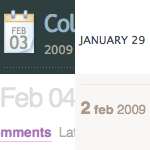 Jonathan Snook ((A web designer I respect a lot, have met in person, and who also sports a rockin’ .ca domain.)) shocked me today with this comment about his new site design:
Jonathan Snook ((A web designer I respect a lot, have met in person, and who also sports a rockin’ .ca domain.)) shocked me today with this comment about his new site design:
True story: I didn’t add dates to the articles on my home page so you can’t [easily] tell how long I go without blog updates.
I struggle as much as the next writer with producing content at regular intervals. Maybe that’s precisely why dates are so vital on the web. Things change, and information goes stale fast. New vistors hitting your site wonder, “Is this site dead?” or “Have I read that already?” If they’re considering subscribing to a feed of your content, they often first wonder, “Are the updates overly frequent?” Jonathan’s suggestion is that they subscribe and find out, but in my experience that’s not how users work. Without dates, content like a blog or news page looks dead.
Dates on articles are even more important, and although they’re rarely omitted, they’re often too subtle or missing key information like the year. People who hit an article from elsewhere want to know, “What’s the context of this? How likely is it to be still true?” I frequently have this problem on corporate sites, where you’re left wondering if the “Cool new Gizmos to launch this summer” still means this summer_. _ Even the almighty 37signals doesn’t give the year on their blog - even if the posts are years old!
My approach is to display full dates everywhere, bolding the day on the index page and the year on the article pages. There are a lot of other options, but for your users’ sake - pick one!